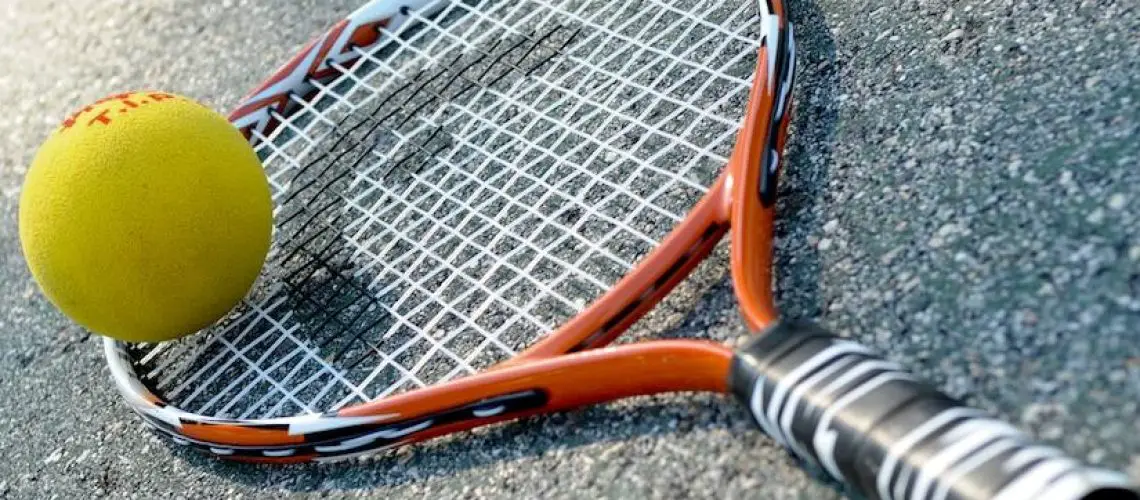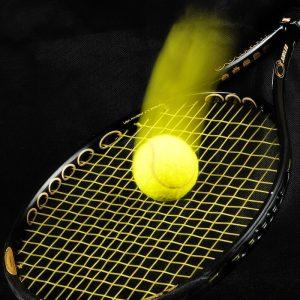We may earn money or products from the companies mentioned in this post.
Brief Overview of Tennis and its Rules

Tennis is a dynamic and exhilarating sport that has captured the hearts of millions around the world Played on a rectangular court, it involves two players (singles) or four players (doubles) battling it out to score points by hitting a ball over a net with a racket
The basic principles of tennis revolve around agility, strategy, and skill Players must serve the ball into the opponent’s side of the court, rally back and forth, and aim to hit shots that their opponents cannot return The objective is to win points by making the ball land within the designated boundaries while avoiding any mistakes or errors
Understanding the rules of tennis is incredibly important for both beginners and seasoned players alike These rules provide structure, fairness, and consistency throughout matches They ensure that everyone competes on an even playing field while allowing for strategic decision-making, sportsmanship, and thrilling displays of athleticism
Definition and Explanation of a “Let” in Tennis

In tennis, a “let” refers to a situation where play is stopped due to certain circumstances It can occur during various instances throughout a match and affects gameplay in unique ways
Instances when a Let Occurs
-
Serve Let:
If a player serves but fails to make contact with the ball or hits it incorrectly – such as hitting the net – it results in what’s called a “serve let” This means that the server gets another opportunity to serve without any penalties -
Court Hindrance Let:
If anything or anyone on or near the court hinders play or distracts one of the players during a point, it can be deemed as a hindrance let In this case, the point is replayed -
Ball Hindrance Let:
If a ball from another court rolls onto your court during a point and it affects the play, it is considered a ball hindrance let The point is replayed in this situation as well
How It Affects Gameplay
A let can have various effects on gameplay In the case of a serve let, it gives the server another chance to deliver a successful serve without any penalties This allows for fair play and eliminates any disadvantage caused by an unintentional error
When it comes to hindrance lets, they provide a fair opportunity for players to focus on their game without any external distractions or obstacles By replaying the point, it ensures that no unfair advantage or disadvantage occurs due to factors beyond the control of the players
In essence, lets are an integral part of tennis rules that contribute to maintaining fairness and sportsmanship throughout matches They allow players to overcome unintended errors or interferences and continue playing with equal opportunities
Types of Lets in Tennis

Tennis is a game filled with excitement and unpredictability One moment, you’re ready to serve or return a powerful shot, and the next, a let is called, throwing off your rhythm Let’s explore the different types of lets that can occur during a tennis match
Service Lets
Service lets occur when there is interference or an error during the serving process There are two main scenarios:
-
Ball touching the net before entering opponent’s service box:
In this situation, the server’s shot hits the net and then lands inside their opponent’s service box It happens both during first serves and second serves -
First serve let scenario:
If it occurs during the first serve, it results in a do-over where the server gets another chance to make a successful serve -
Second serve let scenario:
If it happens during the second serve, it is treated differently The server only gets one attempt at their second serve regardless of whether they hit the net or not -
Receiver not prepared for the serve:
Another type of service let happens when the receiver is not ready for the server’s shot This can be due to various reasons such as distractions or delays in between points
Non-Service Lets
Besides service lets, there are other instances where lets can occur throughout a tennis match These types are known as non-service lets and include:
-
Outside interference during play:
Sometimes external factors come into play and interfere with the game This can include objects on the court, such as loose balls or equipment that may have been left behind -
Objects on court:
If a ball or any other foreign object enters the playing area during a point, it can lead to a let being called -
Noise or distractions:
Noise from spectators, officials, or even the players themselves can cause distractions that disrupt play In such cases, a let is usually called to allow for fair competition -
Unforeseen circumstances causing hindrance to play:
Sometimes unforeseen circumstances arise that hinder the players’ ability to continue the point This could include weather conditions like rain, wind, or extreme heat, making it unsafe or difficult to play
Lets in tennis provide an opportunity for fairness and sportsmanship While they may temporarily interrupt the flow of the game, they ensure that both players have an equal chance to showcase their skills So next time you hear “let” being called on the court, remember that it’s all part of the game!
Allowed Number of Lets in Different Tennis Formats and Competitions

Professional Tennis Tournaments (ATP, WTA)
When it comes to professional tennis tournaments like the ATP (Association of Tennis Professionals) and WTA (Women’s Tennis Association), there are specific rules governing the allowed number of lets per match, service, game, and set A let occurs when the ball hits the net on a serve but still lands within the correct service box
In these tournaments, players are typically allowed one let per serve If they hit another let on that same serve, it is considered a fault However, if a player hits multiple lets during a rally or point, they can continue playing without any consequences
Regarding the difference between men’s and women’s professional matches in terms of allowed lets, there isn’t any distinction Both men and women abide by the same rules and follow the one-let-per-serve regulation
Amateurs and Recreational Tennis Leagues/Rulesets
Amateur and recreational tennis leagues often have variations in their rulesets based on local clubs or groups These variations may impact the allowed number of lets during a match
In some cases, amateur leagues adopt similar rules to professional tournaments where players are allowed one let per serve This helps maintain consistency and familiarity for players transitioning from casual play to more competitive environments
However, other recreational leagues may have different regulations regarding lets Some leagues might allow multiple lets during a single serve without any faults being called This leniency aims to encourage beginners or casual players by reducing potential frustrations caused by frequent net contacts
The Impact on Players’ Strategies
The number of allowed lets can significantly impact players’ strategies on the court In professional tennis where only one let is permitted per serve, players must aim for clean, accurate serves to avoid any faults The limited number of lets puts more pressure on their serving technique and precision
On the other hand, in leagues or tournaments that allow multiple lets per serve, players may adopt a different approach They might take more risks with their serves, knowing that hitting the net doesn’t necessarily result in a fault This leniency can lead to more aggressive play styles and higher-risk serving strategies
Furthermore, the allowance of multiple lets during rallies or points can affect players’ decision-making during gameplay They might choose to continue playing despite hitting multiple nets since it won’t penalize them with a fault This dynamic adds an element of unpredictability to the game and forces players to adapt quickly
In conclusion, the allowed number of lets varies between professional tennis tournaments and amateur/recreational leagues While professionals generally adhere to one let per serve rule, recreational tennis environments may have different regulations based on local clubs or groups These variations influence players’ strategies and add unique dynamics to each setting
Consequences and Controversies Surrounding Lets in Tennis

Disputes between players regarding lets and their resolution by officials/umpires
In the world of tennis, disputes over lets have been a common occurrence throughout history Players often find themselves at odds with officials or umpires when it comes to determining whether a let should be called These disagreements can arise due to various reasons, such as an unclear or subjective interpretation of the rules
Historical examples showcase the intensity of these disputes One notable incident involved John McEnroe during the 1981 Wimbledon Championships McEnroe famously argued with the chair umpire over a let call, venting his frustration and creating controversy
The role of technology has also come into play when it comes to resolving let disputes Hawk-Eye, a ball-tracking system used in professional tennis, allows for more accurate judgments on whether a let has occurred Its implementation has provided a means for players and officials to avoid unnecessary confrontations and make fair decisions
Possible rule changes or modifications: pros & cons
As with any sports rule, there is ongoing discussion about potential changes or modifications related to how many lets are allowed in tennis matches Let’s explore some of the pros and cons associated with these proposed rule changes
-
Elimination or reduction of allowed lets per match/service/game/set:
One argument for reducing or eliminating the number of allowed lets is that it would speed up gameplay and make matches more exciting for spectators However, opponents argue that this could lead to unfair outcomes as players may lose points due to minor interruptions that should be considered insignificant -
Adoption across different levels/types of competition:
Another point of contention revolves around whether the same let rules should apply to all levels of tennis competition Some argue that consistency is essential, allowing players to adapt and compete on an equal playing field On the other hand, opponents suggest that different formats may require specific let rules, taking into account factors such as player skill level or match duration
By delving into the consequences and controversies surrounding lets in tennis, we gain a deeper understanding of this integral aspect of the game Whether it’s disputes between players and officials or discussions about potential rule modifications, the world of tennis continues to navigate through these challenges in search of fair play and enjoyable competitions
Useful Links

What is a Let in Tennis?
HOw many Lets allowed before a fault??
How Many Let Serves Are Allowed in Tennis
What Does a LET Mean in Tennis?
How many lets can I serve
Serve (tennis) – Wikipedia
Beginners Guide To Tennis
Rules of Tennis | Wanless Park Tennis
Breaking the Rules: letting go of the let serve
what is a Let Rule in Tennis: A Comprehensive Guide …
Summary of Tennis Rules
TENNIS RULES
How many serves is a player allowed per game in tennis?
Ping Pong Singles Rules
Table Tennis rules explained: 11 frequently asked questions
Tennis Rules Explained – The Basics of Tennis
Every College Tennis Rule That Is Different Than The Pros
2021-rules-of-tennis-english.pdf
Rules of Platform Tennis






